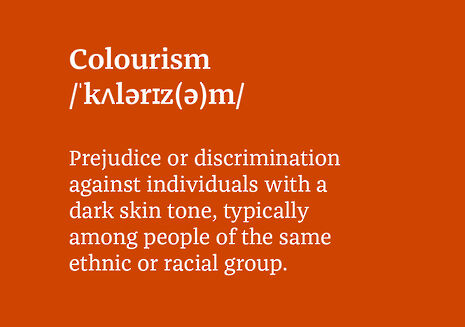Light-skinned people must not be complicit in widespread colourism
Emma Loffhagen argues that addressing colourism will require meaningful change from those who perpetuate it, and from lighter-skinned people of colour who benefit from it

As a black woman, Blackkklansman was a film I was supposed to love. Akin to Girls Trip, Black Panther, Moonlight et al., there was an assumption that when the credits began to roll, the black community should have been on its knees, eternally grateful to the Hollywood masters for finally giving us the representation that we had been so vociferously demanding. However, I did not leave the cinema overwhelmed by this one-dimensional elation. Instead, I was left with a complex but all too familiar sense of frustration. Why, in a film that was in theory so ostensibly and unapologetically black, was the female lead so light?
As a woman of mixed heritage myself, I understand that my perceived ethnic “ambiguity” has given me a free pass over hurdles on which other non-white-passing members of the black community have stumbled. I first began to recognise my position within a social dynamic steeped in colourism as a mixed-race woman when rethinking some of the backhanded 'compliments' I had been given all my life: “You’ve got nice hair for a black girl”, “even though you’ve got big lips you’re still pretty!”, “You’re not like most black girls!” Why, I asked myself, did these comments of “praise” always served to negate my blackness? Why was that which made me valuable that which apparently distanced me from my blackness?
“My perceived ethnic ‘ambiguity’ has given me a free pass over hurdles on which other non-white-passing members of the black community have stumbled”
Yes, these comments chipped away at my sense of identity, but I know that being seen in this way has also been advantageous for me as a woman of colour - and just as white privilege must be recognised by its proprietors, so must light privilege. Light-skinned people must not be complicit in colourism’s erasure of our dark-skinned counterparts by profiting off it. Although I recognise that I cannot and should not speak for anybody in the black community, including those darker-skinned individuals affected by colourism, I feel a personal and social obligation to do my part to help bring these issues to the forefront of racial discourse – this includes recognising my privilege as a light-skinned woman and calling out the complacency of many lighter-skinned members of the black community on this topic.
However, confronting colourism is not as simple as calling upon the black community to engage in self-reflection. While colourism is indeed perpetuated by the black community, from the misogynoir of some black men to the alarming epidemic of skin bleaching, both of which fortify the already axiomatic erasure of dark-skinned women and men, it is crucial that we also remember that its architects are white. Colourism, like its cousin, racism, is inextricably bound to the cotton fields of colonialism, a latent appendage of the legacy of slavery and a by-product of the centuries-old white supremacist ideology that being as close to white as possible is the ultimate ideal. ‘White is right’ has been not-so-thinly veiled as ‘light is right’.
It is no coincidence that so many of the faces of black success, the pioneers of our shiny new “colour blind” society, share a striking approximation to whiteness, nor is it something we can continue to disregard as a non-issue. Whether it be the first black president or black British princess, both share a common dilution of melanin which has rendered them more palatable to a society steeped in Eurocentrism.
As uncomfortable as this reality is to confront, its proliferation is impossible to ignore. However, this is not a topic of conversation that I have found to be common during my time at Cambridge. While I was pleasantly surprised to find that the topic of colourism forms a small part of my HSPS degree, the lecture and supervision participation (or lack thereof) demonstrated that while countless students are well-versed in the most obscure white-narrated sociological trivia, many are unfamiliar with even the most foundational notions of black history – colourism included. For me, attending ACS events within the University and even simply going home to London bring into sharp relief the lack of nuanced discourse and knowledge surrounding race beyond a Western-centric gaze within Cambridge circles. In a majority-white institution like Cambridge, the silence (and ignorance) surrounding these issues can be deafening.
“Members of the white community must not sit back and pat themselves on the back for achieving a white-washed version of diversity and inclusion”
It seems to me that tackling colourism requires a twofold approach: direct recognition and action from those (largely white) people in power, and reflection and allyship from lighter-skinned POC. First of all, colourism relies on perception, and it is those members of our society with the most social capital that construct our perception of ourselves and others. Unsurprisingly, the majority of these authors of our social values are white: Film producers, magazine editors, record labels, and modelling agencies all have the power to uphold, whether consciously or not, this damaging approach to race and ‘diversity’ where darker-skinned people of colour are time and time again left out of the picture.
But there is also work to be done by light-skinned POC to challenge this special treatment that we often receive. Privilege is always uncomfortable to admit, especially if you have been on the receiving end of some form of discrimination yourself, but it is impossible to make significant progress if lighter-skinned women and men continue to profit from this system at the expense and erasure of darker-skinned individuals. It is not enough to simply recognise privilege - we must actively challenge this dominant narrative in everyday life to combat this illusion of inclusion. This process need not be revolutionary; small actions such as stepping aside in roles that are more suited to dark-skinned POC, thoughtfully engaging in discourse surrounding colourism, and speaking out via whatever means available to you are all actions that will slowly but surely help to change the shade of the fabric of our society.
However, there is one thing I need to make clear: while it is completely necessary for lighter-skinned POC to take action and reflect upon where we stand in this dynamic, the dismissal of colourism as an inherently and only “black” problem hinders any possibility of action or concern within the white community. Members of the white community must not sit back and pat themselves on the back for achieving a white-washed version of diversity and inclusion. If true inclusion is really your goal, then this is an issue which you, as a beneficiary or an architect of colourism, must face, and that immediately.
 News / CUP announces funding scheme for under-represented academics19 December 2025
News / CUP announces funding scheme for under-represented academics19 December 2025 News / SU reluctantly registers controversial women’s soc18 December 2025
News / SU reluctantly registers controversial women’s soc18 December 2025 News / Cambridge welcomes UK rejoining the Erasmus scheme20 December 2025
News / Cambridge welcomes UK rejoining the Erasmus scheme20 December 2025 Features / Should I stay or should I go? Cambridge students and alumni reflect on how their memories stay with them15 December 2025
Features / Should I stay or should I go? Cambridge students and alumni reflect on how their memories stay with them15 December 2025 Film & TV / Timothée Chalamet and the era-fication of film marketing21 December 2025
Film & TV / Timothée Chalamet and the era-fication of film marketing21 December 2025










